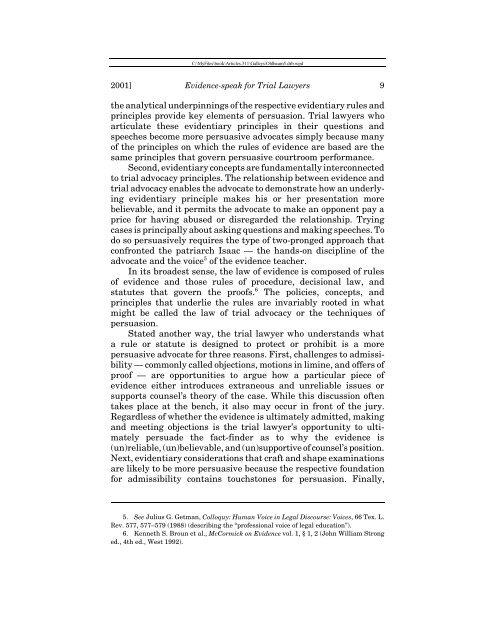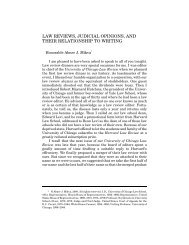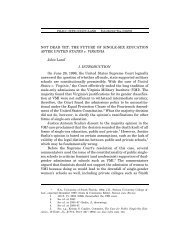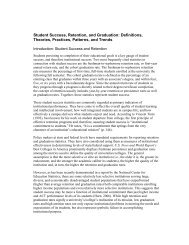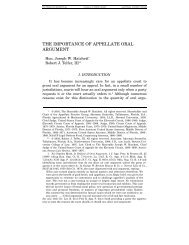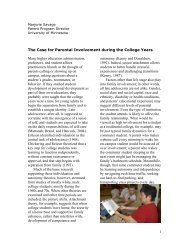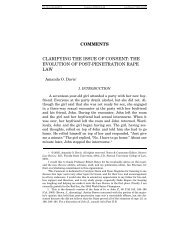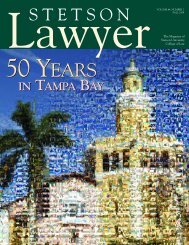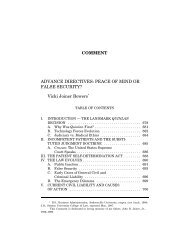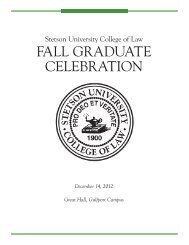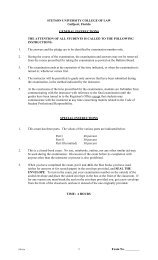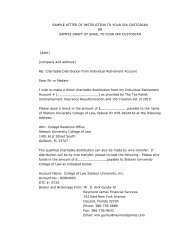Evidence-speak for Trial Lawyers - Stetson University College of Law
Evidence-speak for Trial Lawyers - Stetson University College of Law
Evidence-speak for Trial Lawyers - Stetson University College of Law
Create successful ePaper yourself
Turn your PDF publications into a flip-book with our unique Google optimized e-Paper software.
C:\MyFiles\book\Articles.311\Galleys\Ohlbaum5.drb.wpd2001] <strong>Evidence</strong>-<strong>speak</strong> <strong>for</strong> <strong>Trial</strong> <strong><strong>Law</strong>yers</strong> 9the analytical underpinnings <strong>of</strong> the respective evidentiary rules andprinciples provide key elements <strong>of</strong> persuasion. <strong>Trial</strong> lawyers whoarticulate these evidentiary principles in their questions andspeeches become more persuasive advocates simply because many<strong>of</strong> the principles on which the rules <strong>of</strong> evidence are based are thesame principles that govern persuasive courtroom per<strong>for</strong>mance.Second, evidentiary concepts are fundamentally interconnectedto trial advocacy principles. The relationship between evidence andtrial advocacy enables the advocate to demonstrate how an underlyingevidentiary principle makes his or her presentation morebelievable, and it permits the advocate to make an opponent pay aprice <strong>for</strong> having abused or disregarded the relationship. Tryingcases is principally about asking questions and making speeches. Todo so persuasively requires the type <strong>of</strong> two-pronged approach thatconfronted the patriarch Isaac — the hands-on discipline <strong>of</strong> theadvocate and the voice 5 <strong>of</strong> the evidence teacher.In its broadest sense, the law <strong>of</strong> evidence is composed <strong>of</strong> rules<strong>of</strong> evidence and those rules <strong>of</strong> procedure, decisional law, andstatutes that govern the pro<strong>of</strong>s. 6 The policies, concepts, andprinciples that underlie the rules are invariably rooted in whatmight be called the law <strong>of</strong> trial advocacy or the techniques <strong>of</strong>persuasion.Stated another way, the trial lawyer who understands whata rule or statute is designed to protect or prohibit is a morepersuasive advocate <strong>for</strong> three reasons. First, challenges to admissibility— commonly called objections, motions in limine, and <strong>of</strong>fers <strong>of</strong>pro<strong>of</strong> — are opportunities to argue how a particular piece <strong>of</strong>evidence either introduces extraneous and unreliable issues orsupports counsel’s theory <strong>of</strong> the case. While this discussion <strong>of</strong>tentakes place at the bench, it also may occur in front <strong>of</strong> the jury.Regardless <strong>of</strong> whether the evidence is ultimately admitted, makingand meeting objections is the trial lawyer’s opportunity to ultimatelypersuade the fact-finder as to why the evidence is(un)reliable, (un)believable, and (un)supportive <strong>of</strong> counsel’s position.Next, evidentiary considerations that craft and shape examinationsare likely to be more persuasive because the respective foundation<strong>for</strong> admissibility contains touchstones <strong>for</strong> persuasion. Finally,5. See Julius G. Getman, Colloquy: Human Voice in Legal Discourse: Voices, 66 Tex. L.Rev. 577, 577–579 (1988) (describing the “pr<strong>of</strong>essional voice <strong>of</strong> legal education”).6. Kenneth S. Broun et al., McCormick on <strong>Evidence</strong> vol. 1, § 1, 2 (John William Stronged., 4th ed., West 1992).


